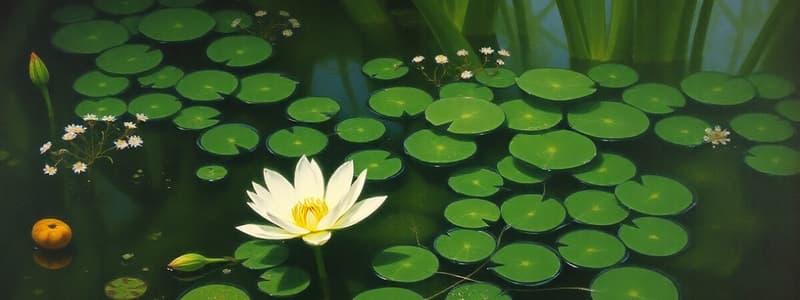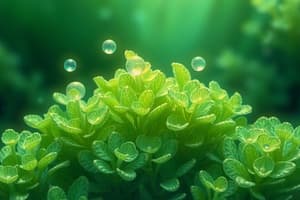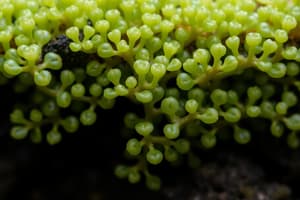Podcast
Questions and Answers
Which pigment is primarily responsible for the red coloration of red algae?
Which pigment is primarily responsible for the red coloration of red algae?
- Carotene
- Chlorophyll a
- Phycoerythrin (correct)
- Chlorophyll b
What is the main component of foram tests?
What is the main component of foram tests?
- Calcium carbonate (correct)
- Silica
- Cellulose
- Chitin
What does the term 'sporophyte' refer to in the Porphyra life cycle?
What does the term 'sporophyte' refer to in the Porphyra life cycle?
- A spore producing structure
- A gamete producing structure
- The haploid generation
- The diploid generation (correct)
Which of these groups is NOT included in the Archaeplastida supergroup?
Which of these groups is NOT included in the Archaeplastida supergroup?
By what process does a zygote become a germinating spore?
By what process does a zygote become a germinating spore?
What is the role of pseudopodia in foraminiferans?
What is the role of pseudopodia in foraminiferans?
Green algae are named for what characteristic?
Green algae are named for what characteristic?
Which of these is not a characteristic of red algae?
Which of these is not a characteristic of red algae?
What is the primary structural material of radiolarian tests?
What is the primary structural material of radiolarian tests?
Which characteristic is shared by both oomycetes and fungi?
Which characteristic is shared by both oomycetes and fungi?
What is the primary function of the micronucleus in ciliates?
What is the primary function of the micronucleus in ciliates?
What distinguishes heteromorphic alternation of generations?
What distinguishes heteromorphic alternation of generations?
What is the shared characteristic among all rhizarians?
What is the shared characteristic among all rhizarians?
What is the major ecological role of diatoms?
What is the major ecological role of diatoms?
What is the common feature used to classify brown algae as a whole?
What is the common feature used to classify brown algae as a whole?
How do radiolarians capture their prey?
How do radiolarians capture their prey?
What is the primary shared characteristic of golden algae that gives them their name?
What is the primary shared characteristic of golden algae that gives them their name?
Which feature is NOT typically associated with the algal body?
Which feature is NOT typically associated with the algal body?
What is a key characteristic that defines the Stramenopila clade?
What is a key characteristic that defines the Stramenopila clade?
What is the primary function of the alveoli found in the Alveolata clade?
What is the primary function of the alveoli found in the Alveolata clade?
What is the proposed origin of the Chromalveolata clade?
What is the proposed origin of the Chromalveolata clade?
What is a distinguishing feature of kinetoplastids?
What is a distinguishing feature of kinetoplastids?
Which unique structure distinguishes the Euglenozoa clade?
Which unique structure distinguishes the Euglenozoa clade?
Which of the following pairs correctly matches an organism to its described characteristic?
Which of the following pairs correctly matches an organism to its described characteristic?
Flashcards
Green Algae Color
Green Algae Color
Green algae are named for their chlorophyll pigments, which give them a green color.
Green Algae Diversity
Green Algae Diversity
Green algae are a diverse group including unicellular, colonial, and multicellular forms.
Land Plants Origin
Land Plants Origin
Land plants evolved from a specific lineage of green algae.
Red Algae Pigment
Red Algae Pigment
Signup and view all the flashcards
Red Algae Habitat
Red Algae Habitat
Signup and view all the flashcards
Red and Green Algae Relationship
Red and Green Algae Relationship
Signup and view all the flashcards
Foraminifera Shells
Foraminifera Shells
Signup and view all the flashcards
Foram Fossil Record
Foram Fossil Record
Signup and view all the flashcards
What are rhizarians?
What are rhizarians?
Signup and view all the flashcards
What are radiolarians?
What are radiolarians?
Signup and view all the flashcards
What are oomycetes?
What are oomycetes?
Signup and view all the flashcards
What is alternation of generations?
What is alternation of generations?
Signup and view all the flashcards
What are diatoms?
What are diatoms?
Signup and view all the flashcards
What are ciliates?
What are ciliates?
Signup and view all the flashcards
What are brown algae?
What are brown algae?
Signup and view all the flashcards
Algal Structure
Algal Structure
Signup and view all the flashcards
Golden Algae Color
Golden Algae Color
Signup and view all the flashcards
Stramenopile Flagella
Stramenopile Flagella
Signup and view all the flashcards
Alveoli in Alveolata
Alveoli in Alveolata
Signup and view all the flashcards
Kinetoplastid DNA
Kinetoplastid DNA
Signup and view all the flashcards
Euglenid Flagella and Metabolism
Euglenid Flagella and Metabolism
Signup and view all the flashcards
Diplomonads and Parabasalids
Diplomonads and Parabasalids
Signup and view all the flashcards
Euglenozoa Uniqueness
Euglenozoa Uniqueness
Signup and view all the flashcards
Study Notes
Chlorophytes
- Most chlorophytes live in fresh water, but many are marine.
- Some chlorophytes live in damp soil, as symbionts in lichens, or in snow.
Green Algae
- Green algae are named for their grass-green chloroplasts (chlorophylls a and b).
- Plants evolved from green algae.
- Chlorophytes include unicellular, colonial, and multicellular forms.
- Two main groups are chlorophytes and charophyceans.
Red Algae and Green Algae
- Red algae and green algae are the closest relatives of land plants.
- Over a billion years ago, a heterotrophic protist acquired a cyanobacterial endosymbiont.
- Photosynthetic descendants evolved into red algae/green algae and glaucophytes.
- Land plants evolved from green algae relatives that evolved from the cyanobacterial endosymbiont.
- Archaeplastida is a supergroup that includes red algae, green algae, charophytes, glaucophytes, and land plants.
Life Cycle: Porphyra
- The life cycle of Porphyra involves both haploid (n) and diploid (2n) stages.
- Alternation of generations occurs, starting with a zygote (2n).
- Meiosis creates haploid spores (n), which then form gametophytes (n).
- Fertilization occurs, restarting the cycle.
Red Algae
- Red algae are reddish due to the accessory pigment phycoerythrin, masking chlorophyll's green.
- They absorb blue light and reflect/transmit red light.
- Color varies from greenish-red in shallow water to dark red/almost black in deep water.
- Red algae are usually multicellular, with some being large seaweeds.
- Red algae are the most abundant large algae in coastal waters of the tropics.
Forams
- Foraminiferans (forams) are named for their porous, multichambered shells (tests) made of calcium carbonate.
- Pseudopodia extend through the pores in the test.
- Foram tests in marine sediments form an extensive fossil record.
Rhizarians
- Rhizarians are a diverse group of protists defined by DNA similarities.
- DNA evidence supports Rhizaria as a monophyletic clade.
- Amoebas move and feed by pseudopodia; some, but not all belong to the clade Rhizaria.
- Rhizarians include forams and radiolarians.
Radiolarians
- Marine radiolarians have tests fused into one delicate piece, usually made of silica.
- Radiolarians use pseudopodia for engulfing microorganisms via phagocytosis.
- Radiolarian pseudopodia radiate from the central body.
Oomycetes
- Oomycetes include water molds, white rusts, and downy mildews.
- They were once considered fungi based on morphological studies.
- Most oomycetes are decomposers or parasites.
- Oomycetes have filaments (hyphae) that facilitate nutrient uptake similar to fungi.
- Phytophthora infestans, an oomycete, causes potato blight.
Alternation of Generations
- A variety of life cycles evolved among multicellular algae.
- The most complex life cycles involve alternation of generations, alternating multicellular haploid and diploid forms.
- Heteromorphic generations are structurally different, while isomorphic generations look similar.
Diatoms
- Diatoms are unicellular algae with unique two-part, glass-like walls of hydrated silica.
- Diatoms are major components of phytoplankton.
- Diatoms are highly diverse.
- Diatoms typically reproduce asexually but can occasionally reproduce sexually.
Ciliates
- Ciliates are a large group of diverse protists, named for their cilia for movement and feeding in fresh water.
- They have large macronuclei, small micronuclei, and are complex cells.
- Micronuclei function during conjugation, a sexual process that creates genetic variation.
- Conjugation is separate from reproduction, which generally occurs by binary fission within the same species.
Brown Algae
- Brown algae are the largest and most complex algae.
- Brown algae are multicellular and mostly marine.
- Brown algae include many species commonly called "seaweeds."
- The algal body (thallus) is plant-like but lacks true roots, stems, and leaves.
- Holdfasts anchor the stem-like stipe, which supports leaf-like blades.
Golden Algae
- Golden algae are named for their color from yellow and brown carotenoids.
- Golden algae cells are typically biflagellated.
- All golden algae are photosynthetic and some are heterotrophic.
- Most are unicellular but some are colonial.
Stramenopiles
- The Stramenopila clade includes several groups of heterotrophs and algae.
- Most have a "hairy" flagellum paired with a "smooth" flagellum.
Alveolata
- Alveolates (a clade: Alveolata) have membrane-bounded sacs (alveoli) beneath the plasma membrane.
- The function of the alveoli is unknown.
- Alveolata includes dinoflagellates, apicomplexans, and ciliates.
Apicomplexans
- Apicomplexans are all animal parasites, causing serious human diseases.
- One end, the apex, contains a complex of organelles specialized for penetrating hosts.
- Apicomplexans have sexual and asexual stages requiring multiple host species to complete their life cycle. Plasmodium is the parasite causing malaria
- Continuously changes surface proteins.
- Requires mosquitoes and humans for life cycle completion.
- Two million people die from Malaria each year.
Kinetoplastids
- Kinetoplastids have a single mitochondrion containing a kinetoplast (DNA mass).
- Kinetoplastids include free-living consumers of prokaryotes, particularly in freshwater, marine, or moist terrestrial ecosystems.
- This group includes Trypanosoma, causing sleeping sickness in humans.
- Frequent changes in surface proteins prevent host immunity (like in Plasmodium).
Euglenozoans
- Euglenozoa is a diverse clade including predatory heterotrophs, photosynthetic autotrophs, and pathogenic parasites.
- Distinguished by a spiral or crystalline rod of unknown function within the flagella.
- Includes kinetoplastids and euglenids. Euglenids have one or two flagella that emerge from a pocket at one end of the cell. Some species are both autotrophic and heterotrophic (mixotrophic) and contain chloroplasts..
Diplomonads and Parabasalids
- Diplomonads and parabasalids are single-celled protists.
- Diplomonads have two nuclei. Giardia intestinalis is an example.
- Parabasalids have undulating membranes. Trichomonas vaginalis is an example.
Dinoflagellates
- Dinoflagellates are a diverse group of aquatic mixotrophs and heterotrophs.
- They are abundant components of both marine and freshwater phytoplankton.
- They have a characteristic shape reinforced by internal cellulose plates; some contain chloroplasts.
- Two flagella allow them to spin through the water. Dinoflagellate blooms cause toxic red tides.
Chromalveolates
- Some data suggest that the clade Chromalveolata is monophyletic, originating in a secondary endosymbiosis event.
- The proposed endosymbiont is a red alga.
- This clade includes alveolates and stramenopiles.
Studying That Suits You
Use AI to generate personalized quizzes and flashcards to suit your learning preferences.




